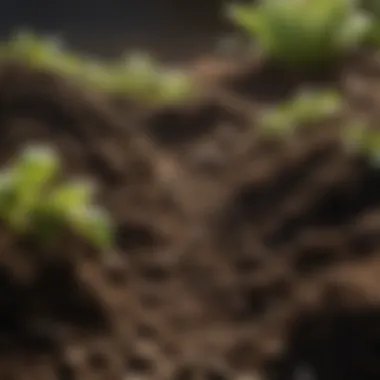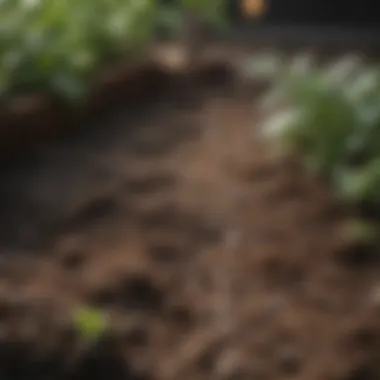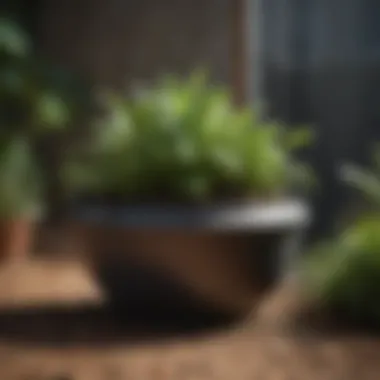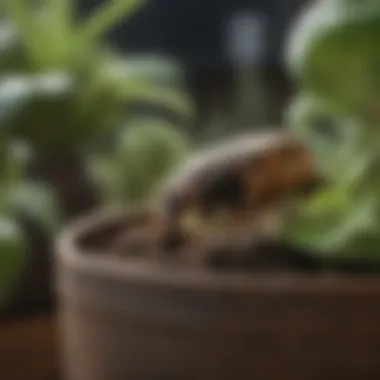Using Garden Soil in Containers: A Comprehensive Guide


Intro
Garden soil is often seen as the cornerstone of any thriving garden. Homeowners and gardening enthusiasts frequently question whether it is suitable for container planting. Using garden soil in pots can carry both benefits and certain risks. Understanding how to adapt garden soil for use in containers is vital for successful gardening. This guide will delve into the composition of garden soil, its drainage properties, nutrient availability, and pest management strategies.
We will also discuss alternatives and soil amendments to improve the condition of potting mixes. Equipped with this information, both novice and experienced gardeners can make informed decisions while potting their plants.
Key Insights and Trends
Soil Composition and Suitability
When considering garden soil for containers, it is essential to evaluate the soil's composition. Garden soil typically includes a blend of sand, silt, clay, and organic matter. Each component plays a different role:
- Sand provides drainage.
- Silt retains moisture.
- Clay helps hold nutrients.
- Organic matter promotes beneficial microbial activity.
However, the exact ratio may not be optimal for container growing. As a result, many gardeners choose to mix garden soil with other media, such as peat moss or perlite, which can enhance drainage and aeration.
Plant Performance Trends
The current trend highlights standing away from traditional soil mixes entirely. Many people are experimenting with soil-less growing mediums such as coconut coir and hydroponic setups. These alternatives can offer specific advantages, including reduced pests and diseases.
"The best soil for containers is not always the soil from your garden. Experiment to find what works best for your plants."
Practical Tips and How-To Guides
Preparing Garden Soil for Containers
- Choose the Right Soil: Select garden soil that is crumbly and has a good texture. Avoid compacted or overly clayey soil.
- Screen the Soil: Remove large debris such as stones, roots, or woody material.
- Amend as Needed: Incorporate organic materials like compost or well-rotted manure to enhance nutrient content. Caution: Too much organic matter can lead to overly dense soil.
- Check Drainage: Test the soil by watering. If water pools on top, you may need to add perlite or sand to improve drainage.
- Sterilize if Necessary: To prevent pests and diseases, consider sterilizing the soil by heating it in an oven or using steam.
Potting Tips
- Use Containers with Drainage Holes: This is crucial for preventing root rot.
- Layering Techniques: Position larger, heavier stones or gravel at the bottom to help with water drainage before adding the garden soil.
- Monitor Watering Needs: Potted plants require attention; ensure you adjust watering according to weather changes and plant requirements.
By following these practical steps, gardeners can maximize the benefits of garden soil in container planting. Remember that every plant is unique and may require different types of care.
In summary, the purpose of this guide is to empower informed gardening choices, ensuring more robust and healthy plants, leading to successful container gardening.
Prologue to Container Gardening
Container gardening serves as a flexible and accessible method for cultivating plants in limited spaces. This approach has gained traction among diverse groups, ranging from urban dwellers to seasoned horticulturists. One of the key merits of container gardening lies in its adaptability, allowing individuals to grow various plants regardless of the outdoor environment.
By utilizing pots and other receptacles, gardeners can maintain control over soil quality, moisture levels, and overall plant health. This method is particularly valuable in urban settings where ground soil may be unsuitable or non-existent. Thus, container gardening emerges as a practical solution for those eager to engage in horticulture while overcoming spatial limitations.
The Popularity of Potted Plants
The rise of potted plants can be attributed to their aesthetic appeal and innovation in gardening practices. People are increasingly drawn to the visual impact that well-arranged container gardens create. Potted plants make striking additions to homes, balconies, and outdoor spaces, crafting a sense of nature within urban life. Their versatility is also noteworthy; pots can be moved around easily, allowing gardeners to experiment with arrangements and placements.
In addition, environmental factors can influence the choice and care of potted plants. With climate change and urban heat islands, many are turning to container gardening as a method to grow organic produce, herbs, and ornamental plants.
Overview of Container Gardening Techniques
Container gardening employs various techniques that cater to different plants and aesthetic preferences. These methods can include:
- Layering: Arranging soil and plants in layers within the container to enhance drainage and promote diverse growth.
- Vertical Gardening: Utilizing vertical space and structures to maximize growing areas.
- Interplanting: Planting complementary species together to optimize growth and deter pests.


Gardeners may also consider their choices based on the specific needs of different plants, ensuring each species flourishes in its container. Understanding these various techniques is crucial for successful container gardening, particularly regarding soil selection and maintenance.
Understanding Garden Soil
Understanding garden soil is critical for any gardener interested in using it for container gardening. Garden soil refers to the earthy material found in the ground, composed of a mixture of organic matter, minerals, gases, liquids, and countless organisms that together support life. This section will delve into the composition of garden soil, the benefits it can provide when used in containers, and the potential drawbacks one should consider before making a decision.
Composition of Garden Soil
The composition of garden soil varies widely depending on geographical location, climate, and prior cultivation practices. Generally, it consists of three primary components:
- Mineral Particles: These are small fragments of rocks that vary in size and type. Sandy soils, for example, contain larger particles, allowing better drainage but also less nutrient retention. Clay soils, in contrast, have very small particles that can hold moisture but may lead to poor drainage.
- Organic Matter: This is decomposed plant material and microorganisms contributing to soil health. Organic matter helps retain moisture and provides important nutrients for plants.
- Air and Water: The balance between air and water in the soil is vital. Good garden soil should have spaces for air to circulate while retaining adequate moisture for plant roots to absorb.
It is the interplay between these components that determines soil quality and capability to support plant growth in containers.
Benefits of Using Garden Soil
Using garden soil in pots can offer several advantages, making it an appealing choice for many gardeners. Some of these benefits include:
- Cost-Effective: It is often more economical than purchasing commercial potting mixes. Many gardeners might already have garden soil available.
- Nutrient-Rich: Garden soil can be nutrient-dense if it has been well maintained. Organic matter enhances soil fertility by providing essential nutrients to plants.
- Ecological Familiarity: Using local garden soil can foster a more natural planting environment for certain plants, as they are acclimatized to this soil's specific biology and chemistry.
However, while the benefits are notable, it is only practical if one evaluates the overall fitness of the soil for container use.
Potential Drawbacks of Garden Soil
Despite the advantages, there are also significant concerns regarding the use of garden soil in containers. Some potential drawbacks include:
- Compaction: Soil from the garden can become compacted in pots. This compaction restricts root growth and can limit access to water and nutrients.
- Poor Drainage: Many garden soils are not specifically designed for containers and may not drain well, leading to waterlogged conditions that can harm plants.
- Pests and Diseases: Garden soil may harbor pests or pathogens that can threaten container plants. These issues might not be present if you used sterilized potting mixes instead.
It is essential to evaluate the specific properties of your garden soil before using it in containers to avoid these pitfalls.
Evaluating Soil Suitability for Pots
Evaluating soil suitability for pots is a critical step in container gardening. For success, gardeners must ensure that their garden soil meets specific requirements for potted plants. This involves checking drainage capabilities and nutrient content. A suitable soil mix can significantly impact the growth and vitality of plants, ultimately influencing the gardening experience.
Analyzing Soil Drainage Properties
Soil drainage is essential when growing plants in containers. Good drainage allows excess water to escape, preventing root rot and fostering healthy plant development. To analyze drainage properties, gardeners can perform a simple test:
- Take a sample of garden soil and place it in a container.
- Soak the soil with water until it is saturated.
- Observe how quickly the water drains. If the water remains pooled at the top for a long time, the soil likely retains too much moisture.
Sandier soils will drain faster, while heavier clay soils may struggle. This characteristic is crucial for container plants, which rely on consistent water levels. In general, a blend of sands, organic matter, and compost can enhance drainage.
Proper drainage promotes healthy root systems and prevents fungal diseases.
Nutrient Detection in Garden Soil
Nutrient content is another vital factor in determining soil suitability for pots. Healthy plants require an array of nutrients, including nitrogen, phosphorus, and potassium, among others. To evaluate nutrient levels, consider these approaches:
- Soil testing kits: Use a kit to measure the pH and essential nutrient levels in your soil. These are readily available and provide invaluable information.
- Observation of Existing Plants: If garden soil is harvested from an area with thriving plants, it likely contains the necessary nutrients. Inspect these plants for signs of deficiencies, such as yellowing leaves or stunted growth.
- Amendments: If the soil lacks nutrients, consider adding organic fertilizers or specific soil amendments to enrich it. Examples include well-rotted manure or balanced fertilizers designed for container gardens.
Risks Associated with Using Garden Soil
Using garden soil in containers can be practical, but there are distinct risks that gardeners must consider carefully. Understanding these risks is crucial for maintaining healthy plants and avoiding potential pitfalls. Soil sourced from outdoor gardens may contain pests, diseases, and contaminants that can adversely affect plants potted in containers. To ensure the best outcomes, it is essential to evaluate these risks and adopt strategies that mitigate them.
Pest Infestation and Disease Transfer


One of the most pressing concerns when utilizing garden soil is the potential for pest infestation and disease transfer. Outdoor soil frequently hosts a variety of organisms, both beneficial and harmful. Common pests such as aphids, fungus gnats, and root maggots can thrive in garden soil. When introduced to containers, these pests can spread rapidly, compromising the health of your plants.
Moreover, garden soil may harbor pathogens like fungi, bacteria, and viruses, which can lead to diseases such as root rot or leaf blight.
"Preventative measures must be taken to minimize pest introductions and disease spread."
To combat this risk, gardeners can heat-treat soil before use, by placing it in an oven at a low temperature for a short duration. Another option involves mixing soil with sterile potting mix, which can dilute any harmful organisms present. Regular monitoring of plants for signs of distress is also vital in managing pest populations and disease symptoms effectively.
Contamination Concerns
Contamination is another significant risk associated with using garden soil. This soil can contain harmful chemicals, heavy metals, or residues from pesticides and herbicides. Such contaminants may leach into the potting mix and affect plant health and safety. For instance, if plants are edible, consuming produce from contaminated soil can pose serious health risks.
It is essential to know the history of the garden soil before incorporating it into pots. Factors such as nearby industrial activity, past use of chemicals, or even the proximity to roads can influence soil contamination levels. A soil test can provide valuable insights into the chemical composition and contamination risk of garden soil.
In summary, while using garden soil in containers offers some advantages, the risks must not be overlooked. By remaining vigilant against pests, diseases, and contaminants, gardeners can enjoy the benefits of garden soil while safeguarding their plants' well-being. A proactive approach paired with informed practices contributes to a more successful container gardening experience.
Best Practices for Mixing Potting Soil
Mixing potting soil is a crucial step in container gardening. The quality of the mix impacts the growth and health of your plants. When combining garden soil with other materials, it is important to consider what you want to achieve. The right mixture can boost drainage, enhance nutrient levels, and suppress disease. These factors are vital for successful outcomes in any container garden.
Recommended Additives for Enhancing Soil Quality
Additives play a significant role in improving the quality of potting soil. Incorporating these materials can make a substantial difference in the growth environment for plants. Some recommended additives include:
- Compost: Enriches soil with nutrients and promotes beneficial microbial life.
- Perlite: Increases aeration and helps with drainage, preventing roots from becoming waterlogged.
- Coconut Coir: Retains moisture while providing a lightweight structure, making it easier for roots to penetrate.
- Vermiculite: Enhances moisture retention and aeration slightly, ensuring roots have space to grow.
- Aged Manure: Provides additional nutrients without burning young plants.
- Charcoal: Improves soil structure and absorbs toxins, benefiting the root zone.
When using these additives, it is critical to choose the right amounts based on the specific needs of the plants being grown. Each additive has unique properties to address, so understanding their effects is vital.
Proper Ratios for Optimal Growth
The balance in the potting soil mix is essential for optimal growth. A common guideline is to follow a basic 3:1:1 ratio. This combination includes three parts garden soil, one part perlite (or another aerator), and one part compost. This method provides a nutrient-rich, well-draining medium that promotes healthy plant growth.
Care should be taken to monitor the particular needs of different plants. For example, herbs may benefit from a higher ratio of compost for increased nutrient availability, while succulents usually require more perlite for improved drainage.
Always adjust the ratios based on the type of plants and their specific requirements to create an ideal growth environment.
Experimentation with ratios and additives can be beneficial. Everyone's conditions are different, and what works in one garden may need modification in another. Regular observation of plant health will guide further adjustments. Being attentive to root growth and moisture levels will assist in refining potting mixes over time.
Alternative Soil Options for Containers
Exploring alternative soil options for container gardening is crucial. This section outlines the effectiveness, benefits, and considerations of various soil types besides garden soil. Selecting the right soil improves plant growth, ensures proper drainage, and minimizes pest issues. Gardeners often seek alternatives due to the limitations and risks associated with using garden soil in containers.
Commercial Potting Mixes
Commercial potting mixes are pre-packaged soil blends designed to support container gardening. These mixes typically contain a blend of peat moss, coconut coir, perlite, and other organic materials. The main advantages of using commercial mixes include consistent quality, optimal drainage, and nutrient availability.
- Consistency: Because they are manufactured under controlled conditions, commercial potting mixes have a uniform texture and composition.
- Nutrient-Rich: Many mixes come pre-fortified with essential nutrients, which promotes better plant growth.
- Lightweight: The materials used make potting mixes easy to handle and ideal for various pots.
- Convenience: Using a ready-made mix saves time and eliminates the need for extensive soil testing or amendments.
However, buyers should be mindful of the presence of synthetic fertilizers. In some cases, these can lead to excessive salt buildup in containers. Additionally, it is advisable to choose mixes labeled organic for a more sustainable gardening approach.
"Choosing the right potting mix can greatly impact your gardening success in containers."
DIY Potting Mix Recipes


Creating your own potting mix can be both economical and satisfying. DIY potting mixes allow gardeners to customize their blends according to specific plant needs. Here are some basic recipes that cater to various container gardening situations:
- Basic Mix for Most Plants:
- Organic Herb Mix:
- Vegetable Mix:
- 1 part peat moss
- 1 part compost
- 1 part perlite or vermiculite
- 2 parts coconut coir
- 2 parts compost
- 1 part vermiculite
- Handful of worm castings
- 2 parts garden soil
- 1 part peat moss
- 1 part compost
- 1 part perlite
DIY mixes allow modifications based on climate and plant species. It is important to ensure proper drainage and aeration. Adding materials like vermiculite or perlite is a good strategy. While the DIY route requires a bit more effort upfront, it offers flexibility and the peace of mind that comes from knowing exactly what is in your potting mix.
Identifying Plant Types Compatible with Garden Soil
Understanding which plants thrive in garden soil is crucial for successful container gardening. Using appropriate plants can significantly influence the health of your garden and optimize the use of garden soil in pots. Certain plants may benefit from garden soil’s natural nutrients and structure, while others may struggle due to poor drainage or nutrient imbalances.
In this section, we will explore various plant types that are compatible with garden soil, focusing on vegetables, herbs, flowers, and ornamentals. Being mindful of these considerations helps gardeners make informed decisions for their potting projects.
Vegetables and Herbs
When it comes to planting vegetables and herbs in containers with garden soil, some types are better suited than others. Many common varieties, like tomatoes, peppers, and basil, thrive well when grown in pots with garden soil.
Benefits of Using Garden Soil for Vegetables and Herbs
- Nutrient-Rich: Garden soil often contains organic matter, which can enhance the growth of plants.
- Improved Flavor: Many gardeners find that the flavor of homegrown vegetables and herbs is superior when grown in natural soil compared to commercial potting mixes.
- Soil Microorganisms: Beneficial microorganisms present in garden soil can aid in plant growth and disease resistance.
However, it is important to consider some elements before planting:
- Drainage: Vegetables may rot if the garden soil retains too much moisture. Ensure pots have adequate drainage holes.
- Sun Exposure: Some vegetables require full sun, while others may prefer partial shade; choose accordingly.
Flowers and Ornamentals
Flowers and ornamental plants can also flourish in garden soil, but careful selection is crucial to success. Varieties like petunias and marigolds may thrive as they are hardy and adapt well to various conditions found in garden soil.
Considerations for Using Garden Soil for Flowers:
- Soil Type: Different flowers have unique needs. Some prefer sandy, well-drained soil, while others require more clay-like conditions.
- Growth Habit: Taller ornamental plants may shade shorter plants. Group them wisely to ensure each plant gets adequate light.
In summary, both vegetables and ornamental plants can be enhanced by using garden soil in containers. Identifying the right types and understanding their specific needs will provide a fruitful and visually appealing potting experience.
Key Takeaway: The compatibility of various plants with garden soil promotes healthier growth and optimal use of resources, making plant selection critical for container gardening.
Ending
The conclusion serves as the cornerstone of the article by synthesizing and emphasizing the importance of utilizing garden soil in container gardening. Through a thorough examination of garden soil's properties, potential risks, and best practices, readers can form an informed approach to selecting and using soil for their potted plants. The significance of understanding both the benefits and drawbacks of garden soil cannot be overstated.
Summary of Key Findings
Using garden soil in containers can present unique challenges and rewards. Here are the key findings:
- Composition Matters: The composition of garden soil can vary widely, impacting drainage and nutrient availability. Therefore, assessing local soil before use is essential.
- Pest and Disease Risks: Garden soil may harbor pests and pathogens. It is crucial to consider these risks and manage them accordingly.
- Mixing for Success: Blending garden soil with potting amendments can enhance its properties. This blending aids in better drainage and nutrient retention, promoting healthier plant growth.
"Understanding the characteristics of garden soil enhances the success of container gardening and plants' health."
Final Recommendations for Garden Soil Usage in Pots
For effective use of garden soil in containers, consider the following recommendations:
- Test Soil First: Always conduct a soil test to analyze nutrient levels and pH. This test will inform any necessary improvements.
- Supplement Wisely: Incorporate materials like perlite, vermiculite, or compost to address drainage and nutrient requirements.
- Choose Compatible Plants: Focus on plants that thrive in the specific conditions your garden soil provides. Vegetables and certain flowers often perform well.
- Monitor Plant Health Regularly: Observing plants for unusual growth patterns can indicate soil problems. Prompt attention can prevent larger issues.
By adhering to these recommendations, homeowners and garden enthusiasts will find that garden soil can be a valuable resource in container gardening. Leveraging the right techniques leads to flourishing plants and a rewarding gardening experience.



